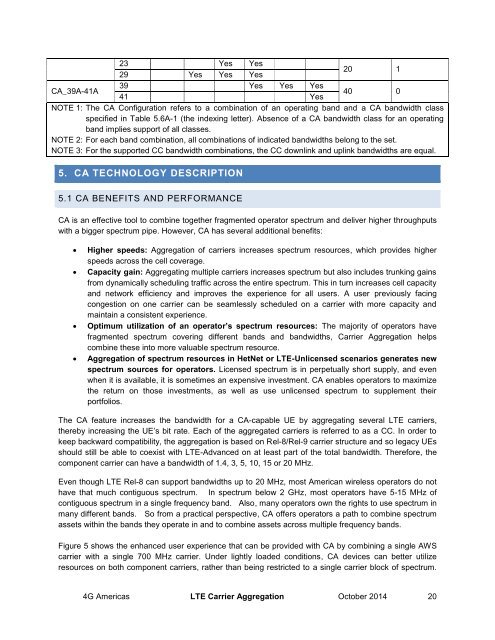4G Americas Carrier Aggregation_FINALv1 0 (2)
4G Americas Carrier Aggregation_FINALv1 0 (2)
4G Americas Carrier Aggregation_FINALv1 0 (2)
Create successful ePaper yourself
Turn your PDF publications into a flip-book with our unique Google optimized e-Paper software.
23 Yes Yes20 129 Yes Yes Yes39 Yes Yes YesCA_39A-41A40 041 YesNOTE 1: The CA Configuration refers to a combination of an operating band and a CA bandwidth classspecified in Table 5.6A-1 (the indexing letter). Absence of a CA bandwidth class for an operatingband implies support of all classes.NOTE 2: For each band combination, all combinations of indicated bandwidths belong to the set.NOTE 3: For the supported CC bandwidth combinations, the CC downlink and uplink bandwidths are equal.5. CA TECHNOLOGY DESCRIPTION5.1 CA BENEFITS AND PERFORMANCECA is an effective tool to combine together fragmented operator spectrum and deliver higher throughputswith a bigger spectrum pipe. However, CA has several additional benefits:Higher speeds: <strong>Aggregation</strong> of carriers increases spectrum resources, which provides higherspeeds across the cell coverage.Capacity gain: Aggregating multiple carriers increases spectrum but also includes trunking gainsfrom dynamically scheduling traffic across the entire spectrum. This in turn increases cell capacityand network efficiency and improves the experience for all users. A user previously facingcongestion on one carrier can be seamlessly scheduled on a carrier with more capacity andmaintain a consistent experience.Optimum utilization of an operator’s spectrum resources: The majority of operators havefragmented spectrum covering different bands and bandwidths, <strong>Carrier</strong> <strong>Aggregation</strong> helpscombine these into more valuable spectrum resource.<strong>Aggregation</strong> of spectrum resources in HetNet or LTE-Unlicensed scenarios generates newspectrum sources for operators. Licensed spectrum is in perpetually short supply, and evenwhen it is available, it is sometimes an expensive investment. CA enables operators to maximizethe return on those investments, as well as use unlicensed spectrum to supplement theirportfolios.The CA feature increases the bandwidth for a CA-capable UE by aggregating several LTE carriers,thereby increasing the UE’s bit rate. Each of the aggregated carriers is referred to as a CC. In order tokeep backward compatibility, the aggregation is based on Rel-8/Rel-9 carrier structure and so legacy UEsshould still be able to coexist with LTE-Advanced on at least part of the total bandwidth. Therefore, thecomponent carrier can have a bandwidth of 1.4, 3, 5, 10, 15 or 20 MHz.Even though LTE Rel-8 can support bandwidths up to 20 MHz, most American wireless operators do nothave that much contiguous spectrum. In spectrum below 2 GHz, most operators have 5-15 MHz ofcontiguous spectrum in a single frequency band. Also, many operators own the rights to use spectrum inmany different bands. So from a practical perspective, CA offers operators a path to combine spectrumassets within the bands they operate in and to combine assets across multiple frequency bands.Figure 5 shows the enhanced user experience that can be provided with CA by combining a single AWScarrier with a single 700 MHz carrier. Under lightly loaded conditions, CA devices can better utilizeresources on both component carriers, rather than being restricted to a single carrier block of spectrum.<strong>4G</strong> <strong>Americas</strong> LTE <strong>Carrier</strong> <strong>Aggregation</strong> October 2014 20


